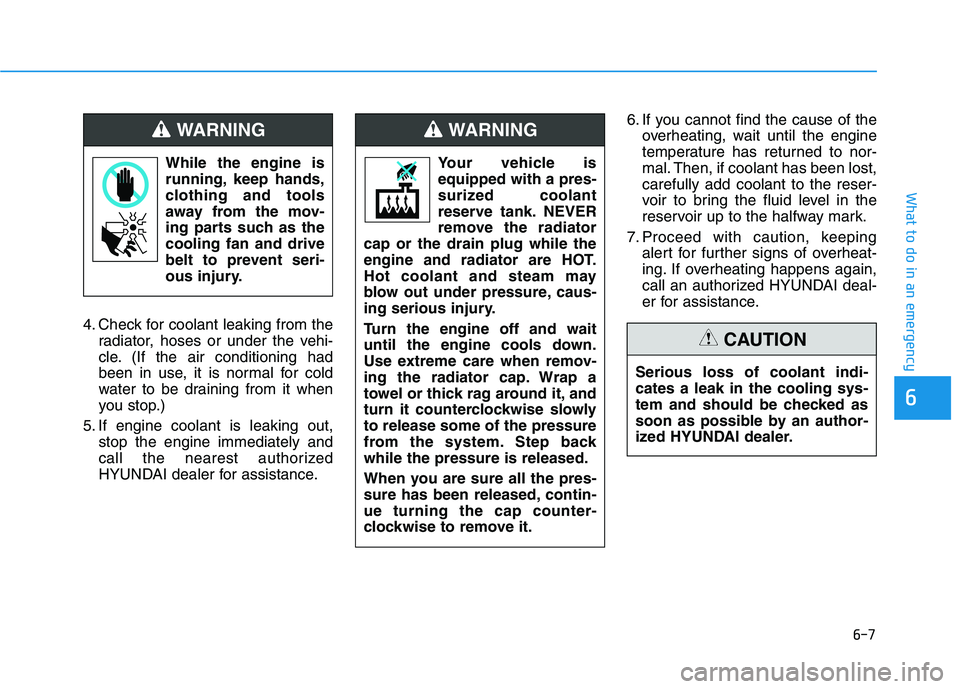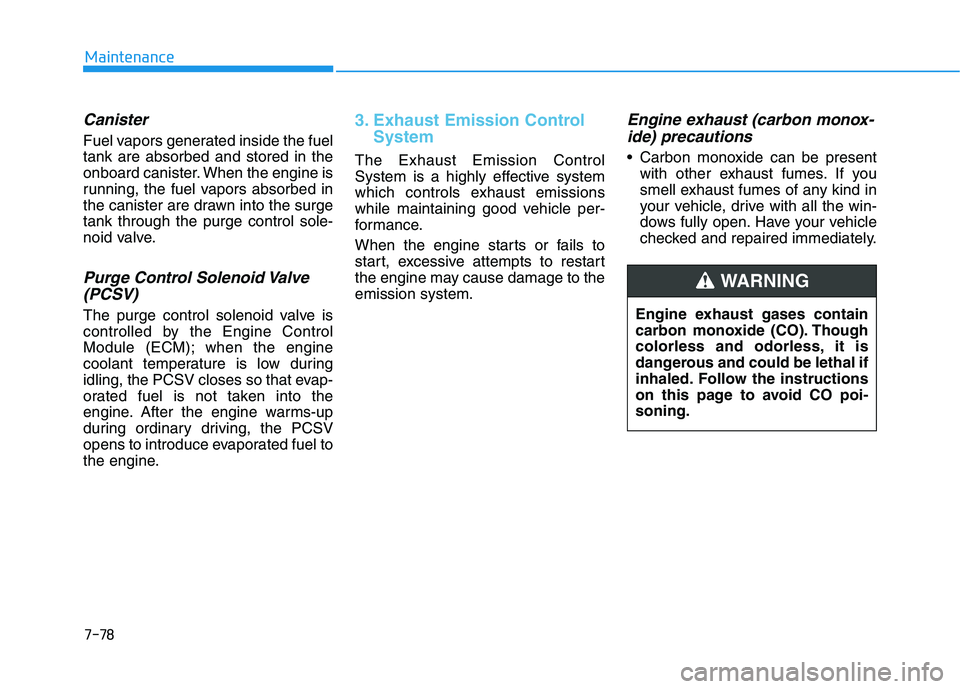Page 486 of 612

6-7
What to do in an emergency
6
4. Check for coolant leaking from the
radiator, hoses or under the vehi-
cle. (If the air conditioning had
been in use, it is normal for cold
water to be draining from it when
you stop.)
5. If engine coolant is leaking out,
stop the engine immediately and
call the nearest authorized
HYUNDAI dealer for assistance.6. If you cannot find the cause of the
overheating, wait until the engine
temperature has returned to nor-
mal. Then, if coolant has been lost,
carefully add coolant to the reser-
voir to bring the fluid level in the
reservoir up to the halfway mark.
7. Proceed with caution, keeping
alert for further signs of overheat-
ing. If overheating happens again,
call an authorized HYUNDAI deal-
er for assistance. While the engine is
running, keep hands,
clothing and tools
away from the mov-
ing parts such as the
cooling fan and drive
belt to prevent seri-
ous injury.
WARNING
Serious loss of coolant indi-
cates a leak in the cooling sys-
tem and should be checked as
soon as possible by an author-
ized HYUNDAI dealer.
CAUTION
Your vehicle is
equipped with a pres-
surized coolant
reserve tank. NEVER
remove the radiator
cap or the drain plug while the
engine and radiator are HOT.
Hot coolant and steam may
blow out under pressure, caus-
ing serious injury.
Turn the engine off and wait
until the engine cools down.
Use extreme care when remov-
ing the radiator cap. Wrap a
towel or thick rag around it, and
turn it counterclockwise slowly
to release some of the pressure
from the system. Step back
while the pressure is released.
When you are sure all the pres-
sure has been released, contin-
ue turning the cap counter-
clockwise to remove it.
WARNING
Page 523 of 612

7-19
7
Maintenance
Do not use a solution that contains
more than 60% antifreeze or less
than 35% antifreeze, which would
reduce the effectiveness of the
solution.
For mixing percentage, refer to the
following table:
Information
If in doubt about the mix ratio, a 50%
water and 50% antifreeze mix is the
easiest to mix together as it will be the
same quantity of each. It is suitable to
use for most temperature ranges of
- 31°F and higher.
i
The electric motor for
the cooling fan may
continue to operate
or start up when the
engine is not running
and can cause serious injury.
Keep hands, clothing and tools
away from the rotating fan
blades of the cooling fan.
Always turn off the engine
unless the vehicle has to be
inspected with the engine on.
Be cautious as the cooling fan
may operate if the negative (-)
battery terminal is not discon-
nected.
WARNING Ambient
TemperatureMixture Percentage
(volume)
Antifreeze Water
5°F (-15°C) 35 65
-13°F (-25°C) 40 60
-31°F (-35°C) 50 50
-49°F (-45°C) 60 40
Never remove the
radiator cap or the
drain plug while the
engine and radiator
are hot. Hot coolant
and steam may blow out under
pressure, causing serious
injury.
Turn the engine off and wait
until the engine cools down.
Use extreme care when remov-
ing the radiator cap. Wrap a
thick towel around it, and turn it
counterclockwise slowly to the
first stop.
WARNING
Step back while the pressure is
released from the cooling sys-
tem. When you are sure all the
pressure has been released,
press down on the cap, using a
thick towel, and continue turn-
ing counterclockwise to remove
it.
OLX2078008
Page 582 of 612

7-78
Maintenance
Canister
Fuel vapors generated inside the fuel
tank are absorbed and stored in the
onboard canister. When the engine is
running, the fuel vapors absorbed in
the canister are drawn into the surge
tank through the purge control sole-
noid valve.
Purge Control Solenoid Valve
(PCSV)
The purge control solenoid valve is
controlled by the Engine Control
Module (ECM); when the engine
coolant temperature is low during
idling, the PCSV closes so that evap-
orated fuel is not taken into the
engine. After the engine warms-up
during ordinary driving, the PCSV
opens to introduce evaporated fuel to
the engine.
3. Exhaust Emission Control
System
The Exhaust Emission Control
System is a highly effective system
which controls exhaust emissions
while maintaining good vehicle per-
formance.
When the engine starts or fails to
start, excessive attempts to restart
the engine may cause damage to the
emission system.
Engine exhaust (carbon monox-
ide) precautions
Carbon monoxide can be present
with other exhaust fumes. If you
smell exhaust fumes of any kind in
your vehicle, drive with all the win-
dows fully open. Have your vehicle
checked and repaired immediately.
Engine exhaust gases contain
carbon monoxide (CO). Though
colorless and odorless, it is
dangerous and could be lethal if
inhaled. Follow the instructions
on this page to avoid CO poi-
soning.
WARNING
Page 603 of 612

I-5
Electric power steering (EPS).........................................3-30
Electrochromatic mirror (ECM) .....................................3-34
Electronic child safety lock system ................................3-20
Electronic Parking Brake (EPB) .....................................5-24
Electronic Stability Control (ESC) .................................5-35
Emergency towing ..........................................................6-24
Emission control system .................................................7-77
Crankcase emission control system ...........................7-77
Evaporative emission control System ........................7-77
Exhaust emission control system ...............................7-78
Engine compartment..................................................1-6, 7-3
Engine compartment panel fuse replacement .................7-50
Engine coolant ................................................................7-18
Engine coolant temperature gauge .................................3-72
Engine number ................................................................8-11
Engine oil ........................................................................7-16
Engine specification..........................................................8-2
Engine Start/Stop button .................................................5-10
Evaporative emission control System.............................7-77
Exhaust emission control system....................................7-78
Explanation of scheduled maintenance items.................7-13
Exterior care....................................................................7-69
Exterior features............................................................3-209
Roof side rails ..........................................................3-209Exterior overview .............................................................1-2
Front view ....................................................................1-2
Rear view......................................................................1-3
Flat tire ............................................................................6-14
Changing a tire ...........................................................6-16
Floor mat anchor(s).......................................................3-204
Fluid
Brake fluid ..................................................................7-21
Washer fluid ...............................................................7-22
Forward Collision-Avoidance Assist (FCA) system ......5-63
Forward/Reverse Parking distance warning system .....3-155
Front air ventilation seat .................................................2-27
Front seat head restraints ................................................2-22
Front seats .........................................................................2-6
Manual adjustment .......................................................2-7
Power adjustment .........................................................2-9
Reclining seatback ..............................................2-8, 2-10
Seatback pocket ..........................................................2-12
Front windshield washers .............................................3-146
Front windshield wipers ...............................................3-144
Fuel filler door ................................................................3-66
Fuel gauge .......................................................................3-73
Fuel requirements
Fuel additives ................................................................F8
Unleaded ........................................................................F7
I
Index
E
F